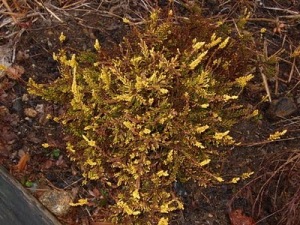Despite the recent spate of Spring-like weather, Chester cannot boast of many outdoor blooms for Bloom Day North on March 15th. Rising to the challenge, however, Sandy Dumaresq has sent photos of blooms taken in her garden to mark the day. In the photo below, a small but healthy Hamamelis Jelena A shows its spidery blossoms to good effect.
 An attractive group of heathers (Caluna Vulgaris “Blazeaway” and others) brighten the landscape that is now devoid of snow.
An attractive group of heathers (Caluna Vulgaris “Blazeaway” and others) brighten the landscape that is now devoid of snow.

Because our climate precludes a wealth of plants in bloom outdoors in March, many Chester gardeners resort to a natural alternative. They bring branches of spring-flowering shrubs indoors, and force the plants to bloom inside, in advance of the season.
Forsythia is a particularly good choice for such an exercise. The profusion of delicate yellow flowers on gracefully arching branches creates a sort of chinoiserie effect that adds a delightful Spring-like air to any room.

According to a recent item in the newsletter on the blog “Dave’s Garden“, the plant is named for William Forsyth. Dave’s newsletter tells us: “Forsyth was a true gardener, rising to curator of the Apothecaries’ Garden (now known as the Chelsea Physic Garden) in the late 1700s where he innovated a rock garden, quite possibly the first of its kind. Later, he was a gardener to St. George, and within the Kensington Palace and St. James Palace, he saw to the cultivation of vegetables and fruits. Among his accomplishments were published works on the management of fruit trees. Martin Vahl named the Forsythia in his honor.”
For those who haven’t yet tried this form of “gardening”, the procedure of forcing blooms is simple. First, make a few incisions at the base of the stems (to encourage an uptake of moisture); then place the branches in a container of tepid water. Set the container in a sunny window and prepare to see a hint of green appear at the growing tips within a week (longer if the branches are cut early in the season). The yellow blossoms gradually emerge, small at first but growing larger as the days go on. Be sure to top up the water in the container as the level drops. Forcing blooms: a tried and true remedy for lifting winter-weary spirits!
Another cure for winter doldrums is to attend the Chester Garden Club’s meetings. Today, March 15, members will hear a presentation on designing and constructing Straw-bale Greenhouses. The doors open at 6:30 pm and the speaker, John Pece, will begin his talk at 7:00 pm.
____________________________________________








 An attractive group of heathers (Caluna Vulgaris “Blazeaway” and others) brighten the landscape that is now devoid of snow.
An attractive group of heathers (Caluna Vulgaris “Blazeaway” and others) brighten the landscape that is now devoid of snow.


